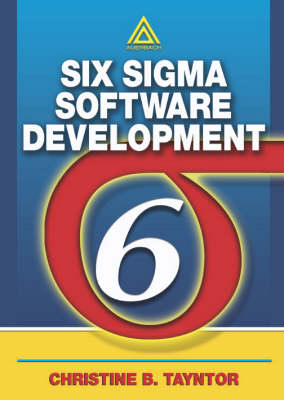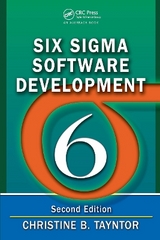
Six Sigma Software Development
Auerbach (Verlag)
978-0-8493-1193-2 (ISBN)
- Titel erscheint in neuer Auflage
- Artikel merken
Since Six Sigma has had marked success in improving quality in other settings, and since the quality of software remains poor, it seems a natural evolution to apply the concepts and tools of Six Sigma to system development and the IT department. Until now however, there were no books available that applied these concepts to the system development process. Six Sigma Software Development fills this void and illustrates how Six Sigma concepts can be applied to all aspects of the evolving system development process. It includes the traditional waterfall model and in the support of legacy systems, but also in more recent development innovations such as rapid application development, packaged software implementation, and outsourcing.
The volume begins with a basic primer of Six Sigma, using a case study to provide a clear explanation of Six Sigma concepts and their application. It then explains the relevance of Six Sigma to the system development process, to quality assurance, and the SEI CMM-mapping the concepts and tools to all aspects of application development. A primary focus is placed on eliminating defects and improving customer satisfaction through the use of tools that help ensure requirements are clearly defined, understood, and met. Finally, the book shows how Six Sigma can be used for more than a single project, in that the concepts can be applied to measure, manage, and improve the performance of your entire IT department.
INTRODUCTION TO SIX SIGMA
Six Sigma in Perspective
The Six Sigma Difference
Managing Change
THE BASICS OF SIX SIGMA
Introduction to DMAIC
Background
The Definition Phase
The Measurement Phase
The Analysis Phase
The Improvement Phase
The Control Phase
SIX SIGMA AND THE TRADITIONAL SDLC
Introduction to the Traditional SDLC
Project Initiation
System Analysis
System Design
Construction
Testing and Quality Assurance
Implementation
SIX SIGMA AND LEGACY SYSTEMS
Introduction to Legacy Systems
Change Management in the IT Department
System Maintenance and Support
INCORPORATING SIX SIGMA INTO OTHER DEVELOPMENT METHODOLOGIES
Rapid Application Development
Prototyping and Spiral Development
Client/Server and Web-Based Systems
SIX SIGMA AND PACKAGED SOFTWARE IMPLEMENTATION
Selecting Packaged Software
Implementing Packaged Software
Six Sigma and Outsourcing
Introduction to Outsourcing
Effective Outsourcing
THE SIX SIGMA IT DEPARTMENT
Putting it All Together
APPENDICES
The Project Charter
The Functional Process Map
The Process Improvement Ranking Spreadsheet
The Failure Modes and Effects Analysis (FMEA)
The Metric Reliability Assessment Spreadsheet
List of Acronyms
Suggested Reading
| Erscheint lt. Verlag | 24.7.2002 |
|---|---|
| Zusatzinfo | 84 Tables, black and white; 34 Illustrations, black and white |
| Verlagsort | London |
| Sprache | englisch |
| Maße | 178 x 254 mm |
| Gewicht | 703 g |
| Themenwelt | Informatik ► Office Programme ► Outlook |
| Mathematik / Informatik ► Informatik ► Software Entwicklung | |
| Wirtschaft ► Betriebswirtschaft / Management ► Logistik / Produktion | |
| ISBN-10 | 0-8493-1193-4 / 0849311934 |
| ISBN-13 | 978-0-8493-1193-2 / 9780849311932 |
| Zustand | Neuware |
| Informationen gemäß Produktsicherheitsverordnung (GPSR) | |
| Haben Sie eine Frage zum Produkt? |
aus dem Bereich



